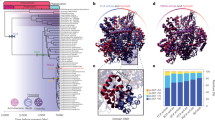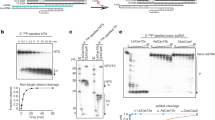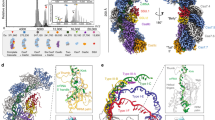Abstract
In a type II clustered regularly interspaced short palindromic repeats (CRISPR) system, RNAs that are encoded at the CRISPR locus complex with the CRISPR-associated (Cas) protein Cas9 to form an RNA-guided nuclease that cleaves double-stranded DNAs at specific sites. In recent years, the CRISPR–Cas9 system has been successfully adapted for genome engineering in a wide range of organisms. Studies have indicated that a series of conformational changes in Cas9, coordinated by the RNA and the target DNA, direct the protein into its active conformation, yet details on these conformational changes, as well as their roles in the mechanism of function of Cas9, remain to be elucidated. Here, nucleic acid-dependent conformational changes in Streptococcus pyogenes Cas9 (SpyCas9) were investigated using the method of site-directed spin labeling (SDSL). Single nitroxide spin labels were attached, one at a time, at one of the two native cysteine residues (Cys80 and Cys574) of SpyCas9, and the spin-labeled proteins were shown to maintain their function. X-band continuous-wave electron paramagnetic resonance spectra of the nitroxide attached at Cys80 revealed conformational changes of SpyCas9 that are consistent with a large-scale domain re-arrangement upon binding to its RNA partner. The results demonstrate the use of SDSL to monitor conformational changes in CRISPR–Cas9, which will provide key information for understanding the mechanism of CRISPR function.




Similar content being viewed by others
References
van der Oost, J., Westra, E. R., Jackson, R. N., & Wiedenheft, B. (2014). Unravelling the structural and mechanistic basis of CRISPR-Cas systems. Nature Reviews Microbiology, 12, 479–492.
Sontheimer, E. J., & Barrangou, R. (2015). The bacterial origins of the CRISPR genome-editing revolution. Human Gene Therapy, 26, 413–424.
Marraffini, L. A. (2015). CRISPR-Cas immunity in prokaryotes. Nature, 526, 55–61.
Makarova, K. S., Wolf, Y. I., Alkhnbashi, O. S., Costa, F., Shah, S. A., Saunders, S. J., et al. (2015). An updated evolutionary classification of CRISPR-Cas systems. Nature Reviews Microbiology, 13, 722–736.
Jiang, F., & Doudna, J. A. (2015). The structural biology of CRISPR-Cas systems. Current Opinion in Structural Biology, 30, 100–111.
Jinek, M., Chylinski, K., Fonfara, I., Hauer, M., Doudna, J. A., & Charpentier, E. (2012). A programmable dual-RNA-guided DNA endonuclease in adaptive bacterial immunity. Science, 337, 816–821.
Gasiunas, G., Barrangou, R., Horvath, P., & Siksnys, V. (2012). Cas9–crRNA ribonucleoprotein complex mediates specific DNA cleavage for adaptive immunity in bacteria. Proceedings of the National Academy of Sciences, 109, E2579–E2586.
Cong, L., Ran, F. A., Cox, D., Lin, S., Barretto, R., Habib, N., et al. (2013). Multiplex genome engineering using CRISPR/Cas systems. Science, 339, 819–823.
Mali, P., Yang, L., Esvelt, K. M., Aach, J., Guell, M., DiCarlo, J. E., et al. (2013). RNA-guided human genome engineering via Cas9. Science, 339, 823–826.
Doudna, J. A., & Charpentier, E. (2014). Genome editing. The new frontier of genome engineering with CRISPR-Cas9. Science, 346, 1258096.
Hsu, P. D., Lander, E. S., & Zhang, F. (2014). Development and applications of CRISPR-Cas9 for genome engineering. Cell, 157, 1262–1278.
Nishimasu, H., Ran, F. A., Hsu, Patrick D., Konermann, S., Shehata, Soraya I., Dohmae, N., et al. (2014). Crystal structure of Cas9 in complex with guide RNA and target DNA. Cell, 156, 935–949.
Jinek, M., Jiang, F., Taylor, D. W., Sternberg, S. H., Kaya, E., Ma, E., et al. (2014). Structures of Cas9 endonucleases reveal RNA-mediated conformational activation. Science, 343, 1247997.
Sternberg, S. H., Redding, S., Jinek, M., Greene, E. C., & Doudna, J. A. (2014). DNA interrogation by the CRISPR RNA-guided endonuclease Cas9. Nature, 507, 62–67.
Anders, C., Niewoehner, O., Duerst, A., & Jinek, M. (2014). Structural basis of PAM-dependent target DNA recognition by the Cas9 endonuclease. Nature, 513, 569–573.
Nishimasu, H., Cong, L., Yan, Winston X., Ran, F. A., Zetsche, B., Li, Y., et al. (2015). Crystal Structure of Staphylococcus aureus Cas9. Cell, 162, 1113–1126.
Jiang, F., Zhou, K., Ma, L., Gressel, S., & Doudna, J. A. (2015). A Cas9–guide RNA complex preorganized for target DNA recognition. Science, 348, 1477–1481.
Sternberg, S. H., LaFrance, B., Kaplan, M., & Doudna, J. A. (2015). Conformational control of DNA target cleavage by CRISPR–Cas9. Nature, 527, 110–113.
Jiang, F., Taylor, D. W., Chen, J. S., Kornfeld, J. E., Zhou, K., Thompson, A. J., et al. (2016). Structures of a CRISPR-Cas9 R-loop complex primed for DNA cleavage. Science, 351, 867.
Hubbell, W. L., Lopez, C. J., Altenbach, C., & Yang, Z. (2013). Technological advances in site-directed spin labeling of proteins. Current Opinion in Structural Biology, 23, 725–733.
Ding, Y., Nguyen, P., Tangprasertchai, N. S., Reyes, C. V., Zhang, X., & Qin, P. Z. (2015). Electron Paramagnetic Resonance. The Royal Society of Chemistry, 24, 122–147.
Hubbell, W. L., Cafiso, D. S., & Altenbach, C. (2000). Identifying conformational changes with site-directed spin labeling. Natural Structural Biology, 7, 735–739.
Fanucci, G. E., & Cafiso, D. S. (2006). Recent Advances and applications of site-directed spin labeling. Current Opinion in Structural Biology, 16, 644–653.
Voinov, M. A., & Smirnov, A. I. (2015). Ionizable nitroxides for studying local electrostatic properties of lipid bilayers and protein systems by EPR. Methods in Enzymology, 564, 191–217.
Smirnova, T. I., & Smirnov, A. I. (2015). Peptide-membrane interactions by spin-labeling EPR. Methods in Enzymology, 564, 219–258.
Sowa, G. Z., & Qin, P. Z. (2008). Site-directed spin labeling studies on nucleic acid structure and dynamics. Progress in Nucleic Acid Research and Molecular Biology, 82, 147–197.
Reginsson, G. W., & Schiemann, O. (2011). Studying biomolecular complexes with pulsed electron-electron double resonance spectroscopy. Biochemical Society Transactions, 39, 128–139.
Yang, Z., Kurpiewski, M. R., Ji, M., Townsend, J. E., Mehta, P., Jen-Jacobson, L., & Saxena, S. (2012). ESR spectroscopy identifies inhibitory Cu2+ sites in a DNA-modifying enzyme to reveal determinants of catalytic specificity. Proceedings of the National Academy of Sciences, 109, E993–E1000.
Shelke, S. A., & Sigurdsson, S. T. (2012). Site-Directed Spin Labelling of Nucleic Acids. European Journal of Organic Chemistry, 2012, 2291–2301.
Krstic, I., Endeward, B., Margraf, D., Marko, A., & Prisner, T. F. (2012). Structure and dynamics of nucleic acids. Topics in Current Chemistry, 321, 159–198.
Ishii, T. M., Zerr, P., Xia, X.-M., Bond, C. T., Maylie, J., & Adelman, J. P. (1998). Methods in Enzymology (Vol. 293, pp. 53–71). New York: Academic Press.
Fang, Y., Cai, Q., & Qin, P. Z. (2005). The procapsid binding domain of phi29 packaging RNA has a modular architecture and requires 2′-hydroxyl groups in packaging RNA interaction. Biochemistry, 44, 9348–9358.
Qin, P. Z., Haworth, I. S., Cai, Q., Kusnetzow, A. K., Grant, G. P. G., Price, E. A., et al. (2007). Measuring nanometer distances in nucleic acids using a sequence-independent nitroxide probe. Nature Protocols, 2, 2354–2365.
Tangprasertchai, N. S., Zhang, X., Ding, Y., Tham, K., Rohs, R., Haworth, I. S., & Qin, P. Z. (2015). An integrated spin-labeling/computational-modeling approach for mapping global structures of nucleic acids. Methods in Enzymology, 564, 427–453.
Smith, P. K., Krohn, R. I., Hermanson, G. T., Mallia, A. K., Gartner, F. H., Provenzano, M. D., et al. (1985). Measurement of protein using bicinchoninic acid. Analytical Biochemistry, 150, 76–85.
Zhang, X., Cekan, P., Sigurdsson, S. T., & Qin, P. Z. (2009). Studying RNA using site-directed spin-labeling and continuous-wave electron paramagnetic resonance spectroscopy. Method Enzymol., 469, 303–328.
Altenbach, C., López, C. J., Hideg, K., & Hubbell, W. L. (2015). Exploring structure, dynamics, and topology of nitroxide spin-labeled proteins using continuous-wave electron paramagnetic resonance spectroscopy. Methods in Enzymology, 564, 59–100.
Mchaourab, H. S., Lietzow, M. A., Hideg, K., & Hubbell, W. L. (1996). Motion of spin-labeled side chains in T4 lysozyme. Correlation with protein structure and dynamics. Biochemistry, 35, 7692–7704.
Josephs, E. A., Kocak, D. D., Fitzgibbon, C. J., McMenemy, J., Gersbach, C. A., & Marszalek, P. E. (2015). Structure and specificity of the RNA-guided endonuclease Cas9 during DNA interrogation, target binding and cleavage. Nucleic Acids Research, 43, 8924.
Szczelkun, M. D., Tikhomirova, M. S., Sinkunas, T., Gasiunas, G., Karvelis, T., Pschera, P., et al. (2014). Direct observation of R-loop formation by single RNA-guided Cas9 and Cascade effector complexes. Proceedings of the National Academy of Sciences, 111, 9798–9803.
Acknowledgments
This work has been supported, in part, by the National Science Foundation (P.Z.Q., CHE-1213673) and the National Institutes of Health (P.Z.Q., RR028992). Research in RR’s lab was supported by an Institutional Development Award (IDeA) from the National Institute of General Medical Sciences of the National Institutes of Health under the Grant Number P20GM103640 and partly by a grant from the Research Council of the University of Oklahoma Norman Campus.
Author information
Authors and Affiliations
Corresponding author
Additional information
Carolina Vazquez Reyes and Narin S. Tangprasertchai have contributed equally.
Rights and permissions
About this article
Cite this article
Vazquez Reyes, C., Tangprasertchai, N.S., Yogesha, S.D. et al. Nucleic Acid-Dependent Conformational Changes in CRISPR–Cas9 Revealed by Site-Directed Spin Labeling. Cell Biochem Biophys 75, 203–210 (2017). https://doi.org/10.1007/s12013-016-0738-5
Received:
Accepted:
Published:
Issue Date:
DOI: https://doi.org/10.1007/s12013-016-0738-5




